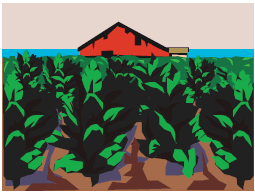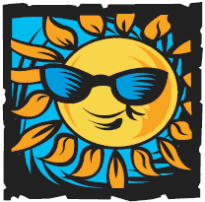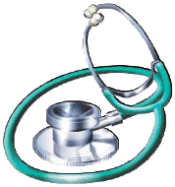

To send a message to an author, click on the author's name at the end of the article.
This Month in Ag Connection | Ag Connection - Other Issues Online
Smartphones and tablets are becoming more entrenched in the daily life of agricultural production. Having email and web access is certainly a big plus to these devices, but the applications (apps) available enhance their effectiveness as a management tool. When speaking to farmers, a weather app is always the most common, usually followed by something to check the markets. From there, the apps used can be as diverse as the products farmers are producing.

For corn and soybean producers, crop scouting is an important tool for identifying problems. Through the growing season, a farmer needs to stay on top of weed and insect pressures. When crops are harvested, scouting can be a good time to repair drainage problems or review yield mapping information and determine why a particular spot in a field is consistently below average. This is where a crop scouting app might be of help.
Here is a list of some crop scouting apps available:
ID Weeds. The University of Missouri Extension ID Weeds app allows one to search for weeds by their common or Latin name, view a list of weeds, or identify weeds based upon a number of different characteristics. Details about each weed are presented, along with photograph(s) of the weed specified. (iPhone, iPad or Android Phone /Tablet). Price - Free.
ScoutPro Corn. This app allows users to scout and identify weeds, insects, disease and disorders while in the field. Users are then able to upload important field data, images and notes to generate field specific scouting reports specific to corn production. (iPad or Android Tablet). Price - $29.99.
ScoutPro Soy. This app is similar to ScoutPro - Corn - but designed for soybean production. (iPad or Android Tablet). Price - $29.99.
eCropScout. App for farmers, agronomists and agricultural professionals to save all their information: field scouting, insect and disease scouting, chemical applications, fertilizer/manure applications, planting data, and harvesting data. (iPad). Price - Free.
FarmLogs. This app allows one to record various activities while in the field in a simple format. (iPhone, iPad). Price - Free.
Pioneerr Field360TM Notes. This app pinpoints your field location via satellite imagery so you can record notes or photos on the spot. Instantly organize your crop scouting information by location to save or share, putting timely growing season info in your hands with your preferred mobile device. (iPhone, iPad). Price - Free.
Connected Farm. - Trimble's Connected FarmT app uses your phone's GPS for mapping field boundaries, locate irrigation pivots, marking flags, and entering scouting information for points, lines, and polygon areas. Scouting attributes include an extensive list of weeds, insects and diseases, and allows you to log the severity of a problem, crop conditions, and more. Photos can be captured and integrated with your scouting attributes. (iPhone, iPad or Android Phone / Tablet). Price - Free
AGRIplot. This app will automatically calculate the area enclosed by plotted points. One can even take pictures associated with a landmark or interest point for a visual representation along with notes. (iPhone, iPad). Price - $0.99.
The bottom line with any crop scouting app is the idea one can have better records over the long-term and have better communication with their crop team (whether an extension specialist, agronomist, custom applicator, etc.). It may also mean scouting happens more regularly, given the ease. Whichever way you look at it, crop scouting apps can have an impact on your management decisions.
Source: Kent Shannon, Natural Resource Engineering Specialist
This Month in Ag Connection | Ag Connection - Other Issues Online
Summer is upon us, and now is a good time to review a few management ideas for beef cattle operations.
If limited hay supplies are a concern, consider trying to bale and ammoniate wheat straw. While it won't turn straw into alfalfa quality feed, ammoniation will improve the digestibility of straw. When properly used in conjunction with other feedstuffs, ammoniated wheat straw can help stretch limited forage supplies.
Bale and cover the straw as soon as possible after harvest. Apply anhydrous ammonia at the rate of 60 pounds of ammonia per ton of dry straw. Use proper precautions when handling anhydrous ammonia. Analyze the ammoniated straw and other feedstuffs for nutrient content so proper supplementation programs can be developed.

Assess pastures for weed control needs. Apply appropriate control measures for the weeds present and consider re-seeding with cool-season grasses in late summer or early fall if grass stands are thin.
If pasture availability becomes limited, begin reducing animal numbers. Start with old, open and ornery cows. If forage demand still needs to be reduced, consider early weaning the calves. The cost of feeding the calves must be considered, but don't assume calves can't be early weaned due to high feed costs without weighing all the costs and benefits.
Heat stress is always a concern in the summer months in Missouri. Researchers at the USDA Meat Animal Research Center (MARC) at Clay Center, NE have information on their web site concerning heat stress in beef cattle. Detailed information is available by clicking on various heat stress topics, including heat stress forecast maps. These maps are made using the seven day forecasts of four weather parameters (temperature, humidity, wind speed, and cloud cover) from the National Oceanic and Atmospheric Administration (NOAA) - National Weather Service (NWS). Heat stress forecasts for up to 7 days are available. The MARC website is available at http://tinyurl.com/cgo4ps . This might be useful when planning livestock work during the summer months.
If you have questions on these or other livestock issues, please contact one of the regional livestock specialists or your local MU Extension Center.
Source: Gene Schmitz, Livestock Specialist
This Month in Ag Connection | Ag Connection - Other Issues Online
It is common to harvest hay from a neighbor's acreage that would otherwise be unused. This practice can have some temporary advantages for both the landowner and the operator, but there are often questions about equitable compensation.
The table shows estimates for the economic costs of harvesting hay where the landowner contributes only land. No nitrogen or application costs are estimated, only the value of the phosphate and potash in the crop. According to the National Research Council, removal rates are 12 and 47 pounds respectively, per ton of cool season grass hay.

Under this typical scenario, incentives are upside down. The cost of harvest exceeds the value of the crop, so the parties have to agree how to share an economic loss. Perhaps not realized, the negative gap has widened in recent years with much higher prices for fertilizers and relatively moderate increases in grass hay values over time, excluding drought conditions. If gross returns are shared based on each party's contribution to costs, the split is 64-36. This arrangement cost the landowner $49 and the operator $29, per acre.
In practice, the landowner may choose to ignore a land rental rate just to have the field cut. If the real estate charge is set to zero, the landowner contribution is the
value of the two major plant nutrients-$74 per acre with a two ton yield. Now, the landowner contributes roughly one-half the total recognized cost of $145. In a 50-50 arrangement each party receives the equivalent of $58.50 per acre or $22.50 per bale as cash or hay. The net effect is the operator loses about $13 and the landowner foregoes rent and donates about $16 of fertility per acre.
If this is a friendly agreement on small acreage and the soil levels of these nutrients are very high or even in excess, the 50-50 agreement may be workable for both parties temporarily. However, for multiple seasons or fields with only moderate levels of phosphate or potash, high fertilizer prices setup a strong disincentive for the landowner to allow uncompensated nutrients to be hauled away. In this case, it is better to let the standing crop "go to waste".
Over time, grass stands are permanently harmed if nutrients are not replaced at the rate of removal. It is important for all parties to appropriately account for the value of the nutrients and find a way to equitably share in the cost of replacement.
Source: Brent Carpenter, Ag Business Management Specialist

This Month in Ag Connection | Ag Connection - Other Issues Online
The editorial board for Ag Connection would like to say thank you to Jim Jarman for his 35 years of service. Jim retired on May 29, 2013. He spent the last 16 years serving Callaway County. Jim has been a valuable MU Extension Agronomist and strong contributor to this newsletter. He was always willing to help others and he was a great support of the agricultural producers of Missouri. Jim’s comradely and friendship will be truly missed.
Author: Joni Harper, Ag Connection Editor
This Month in Ag Connection | Ag Connection - Other Issues Online
Many farmers have established medical reimbursement plans for their employees. A couple of filing requirements for businesses that offer medical reimbursement plans have come to light. The first filing due date is July 31, 2013 and a second filing due date will be January 15, 2014.

The first filing will be Form 720 "Quarterly Federal Excise Tax Return" for an excise tax of $1 per life covered by the medical reimbursement plan. The funds from this excise tax will help fund the Patient-Centered Outcomes Research Institute. This excise tax is required to be reported annually on the 2nd quarter Form 720. The fees to be reported by the July 31, 2013 date are for reimbursement plan years ending on or after October 1, 2012 and before January 1, 2014. This excise tax is scheduled to continue through October 1, 2019 and will be $2 per life covered for plan years ending after 2012.
The second filing for employers providing self-insured health plans is a fee (tax) to help stabilize the premiums for policies covering high-cost individuals. Each employer is to submit their annual self-insured enrollment count to Health and Human Services (HHS) by November 15 of their benefit year. Health and Human Services will notify the employer (plan sponsor) of the amount of their tax by December 15th and the employer has 30 days to remit the fee (tax). For 2013, the fee (tax) is scheduled to be $63 per enrollee in the plan.
Source: Parman R. Green, Ag Business Mgmt. Specialist
This Month in Ag Connection | Ag Connection - Other Issues Online
Publishing Information
Ag Connection is published monthly for Northeast and Central areas of Missouri producers and is supported by the University of Missouri Extension, the Missouri Agricultural Experiment Station, and the MU College of Agriculture, Food and Natural Resources. Managing Editor: Mary Sobba.